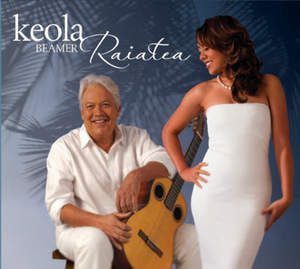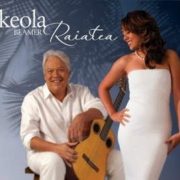KEOLA BEAMER & RAIATEA HELM – KEOLA BEAMER & RAIATEA
ARTIST: KEOLA BEAMER & RAIATEA HELM
TITLE: KEOLA BEAMER AND RAIATEA
LABEL: MOUNTAIN APPLE
RELEASE DATE: MAY 4, 2010
A MAGICAL MUSICAL COMBO
 The ‘ukeke is a small, three-stringed Hawaiian instrument made of koa wood, plucked while held in the mouth, which acts as a resonating chamber. Its otherworldly pulsating sound would not bring to mind John Lennon. But in the first 12 beats of Keola Beamer & Raiatea, a lone ‘ukeke ushers in the opening notes of Imagine. Played by Moanalani Beamer (Keola Beamer’s wife and ensemble member), it keeps solemn time while Keola Beamer and Raiatea Helm perform the song in beautifully intertwined Hawaiian and English. Keola accompanies their vocals in his signature slack key (ki ho ‘alu) guitar style and the Spring Wind Quintet enriches the arrangement. Hawaiian chanting (oli) by Charles Ka’upu brings this unique version of Imagine to a close. The effect is of a universal hymn.
The ‘ukeke is a small, three-stringed Hawaiian instrument made of koa wood, plucked while held in the mouth, which acts as a resonating chamber. Its otherworldly pulsating sound would not bring to mind John Lennon. But in the first 12 beats of Keola Beamer & Raiatea, a lone ‘ukeke ushers in the opening notes of Imagine. Played by Moanalani Beamer (Keola Beamer’s wife and ensemble member), it keeps solemn time while Keola Beamer and Raiatea Helm perform the song in beautifully intertwined Hawaiian and English. Keola accompanies their vocals in his signature slack key (ki ho ‘alu) guitar style and the Spring Wind Quintet enriches the arrangement. Hawaiian chanting (oli) by Charles Ka’upu brings this unique version of Imagine to a close. The effect is of a universal hymn.
This opening number is one of many musical delights on Keola Beamer & Raiatea. When luminaries from two Hawaiian musical generations collaborate to produce a CD like this, there is cause for optimism about the future of Hawaiian music.
Interestingly, John Lennon’s Imagine album entered the American consciousness at a time when Hawaiian cultural consciousness was beginning to experience a renaissance. Young musicians were eager to learn slack key guitar with its dozens of expressive tunings, while many of their peers embraced ancient (kahiko) and modern (auana) hula, female and male falsetto (leo ki’eki’e) singing, and explored Hawaiian history, flora, and folklore. Keola Beamer came of age as a slack key guitarist, composer/lyricist, and vocalist during this era of surging ethnic pride. His upbringing in the Beamer family virtually guaranteed that he would be well-versed in what his mother, revered hula teacher and folklorist Winona Beamer, termed Hawaiiana. His great-grandmother, Helen Desha Beamer, was a prolific composer whose work is represented in two cuts on the CD. A master of tonal coloration in slack key guitar and an artful lyricist, Beamer has produced too many CDs and too many now-classic songs to list. But if you want to know this reviewer’s favorite Keola song, it is Mauna Kea.
Most likely young Raiatea Helm would not be drawing crowds or might not even have dared to base her singing career in Hawaiian culture without the intense musical output of Keola Beamer’s generation. Still in her early 20s, Helm has few peers in the art of female falsetto singing and overall expressiveness in interpretation of Hawaiian songs. She can also put across a jazz standard with surprising verve as with her version of At Last in her second solo CD, Sweet and Lovely, which earned a Grammy nomination in 2006. She has garnered multiple Na Hoku Hano Hano awards (Hawaiian Grammies) as has Beamer. Their first collaboration was to perform Imagine at a cultural festival on O’ahu in 2008. Beamer was immediately struck with her soulful yet delicate vocal quality and soon invited her to collaborate
Thematically, the CD draws upon Keola Beamer’s life journey. He finds himself part of the older generation, experiencing loss and longing for renewal. Where I Hold You, sung by Raiatea in Hawaiian with refrains in English, refers to, in Keola’s words, “that special place in your heart (where) you hold a memory of somebody.” Beamer wrote it upon the passing of his grandfather in 1992. The following cut, Our Time for Letting Go, commemorates Beamer’s mother, Hawai’i’s revered Aunty Nona, who passed away in 2008. He sings it in English accompanying himself on slack key. The controlled emotion of his vocals and the signature simplicity of the melody and lyrics making a universal statement as in his refrain:
A time for love, a time for letting go
And time for all the small regrets to pass
A time for love, and time for letting go of the past
Our time for letting go…letting go
Prolific Hawaiian composer Kuiokalani Lee whose musical generation came before Beamer’s (Don Ho sang many of his songs), provides Beamer with an eloquent vehicle for exploring the past in Days of My Youth. Keola goes solo on English vocals, accompanying himself with softly ornamented ki ho’alu guitar.
Two songs by non-Hawaiians continue the theme of love and loss and, with Beamer’s deft treatment, become vehicles of Hawaiian expression. Leslie Bricusse, known for such Anthony Newley vehicles as What Kind of Fool Am I, wrote When I Look in Your Eyes. The composer could not have envisioned Beamer’s intimate ki ho’alu arrangement accompanied by Harry Willemsen on Indonesian siter. Raiatea handles the vocals in Hawaiian and English with gentle sensitivity.
Keola also sings lead vocals in a Hawaiian translation of Who Knows Where the Time Goes? by Sandy Denny. The hauntingly beautiful arrangement includes the Spring Wind Quintet whose soaring flute evokes the rising of the birds across the evening sky. Raiatea echoes wordless high notes as the Hawaiian text conveys the changing of the seasons.
But the passage of time is not the only thematic thread in Keola Beamer and Raiatea. With You Somebody, we get an inspirational pop genre number with a Hawaiian twist. Although it is sung in English, the expression You Somebody is Hawaiian Pidgin English. Beamer composed it for a musical of the same title written in Pidgin by playwright/lyricist Lee Cataluna in 1992. Raiatea gives it sincere treatment, conveying the difficulties of life with compassion as well as the strength and joy of offering support to someone she loves. A piano, bass, and drumset join up with Beamer’s ki ho’alu accompaniment to give the song a more mainstream feel than most of the cuts on the album.
Four mele (songs) particularly showcase the Hawaiian vocal tradition which Raiatea has embraced. Ka Makani Ka’ili Aloha (literally meaning “the love-snatching wind”) by Mathew Kane is a love song familiar to Hawaiians that dates from the early 1920s. Hilo Hanakahi by Keola Naumu pays tribute to the whispering sea, dust-raising winds, and other natural features of different districts of Hawai’i Island. Ke Ali’i Hulu Mamo by Beamer’s great-grandmother Helen Desha Beamer has Raiatea singing her ha’iha’i, (yodel effect produced by changing between vocal registers) in the lower notes, which is especially affecting in the transitions from minor to major key in each verse. While the melodies are memorable, understanding the poetic lyrics enriches the listening experience. Fortunately, the liner notes to this CD are accessible on-line and contain translations of the Hawaiian mele.
The final two cuts of Keola Beamer and Raiatea are his solo rendition of Days of My Youth followed by one of Helen Desha Beamer’s most beloved songs, Kimo Hula. In her own musical arrangement, Raiatea sings this last mele accompanying herself on the ukulele. While we expect Beamer’s creative output to continue through his golden years, it feels as if Uncle Keola, now finding himself an elder statesman of Hawaiian music, is handing the stage over to a member of the fresh, gifted new generation of musicians he has helped to nurture.
Don’t miss an opportunity to see Keola Beamer and Raiatea Helm at the Shannon Center for the Performing Arts at Whittier College on October 30, 2010. They will be performing at 3:00pm and 8:00pm for the Center’s Aloha Concert Series. For ticket information and directions, go to www.shannoncenter.org or call the box office at 562-907-4203.
Audrey Coleman is a journalist, educator, and passionate explorer of traditional and world music.













